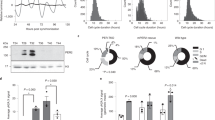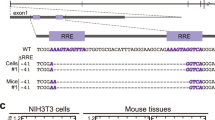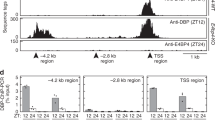Abstract
Mammalian circadian rhythms are based on transcriptional and post-translational feedback loops. Essentially, the activity of the transcription factors BMAL1 (also known as MOP3) and CLOCK is rhythmically counterbalanced by Period (PER) and Cryptochrome (CRY) proteins to govern time of day–dependent gene expression1. Here we show that circadian regulation of the mouse albumin D element–binding protein (Dbp) gene involves rhythmic binding of BMAL1 and CLOCK and marked daily chromatin transitions. Thus, the Dbp transcription cycle is paralleled by binding of BMAL1 and CLOCK to multiple extra- and intragenic E boxes, acetylation of Lys9 of histone H3, trimethylation of Lys4 of histone H3 and a reduction of histone density. In contrast, the antiphasic daily repression cycle is accompanied by dimethylation of Lys9 of histone H3, the binding of heterochromatin protein 1α and an increase in histone density. The rhythmic conversion of transcriptionally permissive chromatin to facultative heterochromatin relies on the presence of functional BMAL1-CLOCK binding sites.
This is a preview of subscription content, access via your institution
Access options
Subscribe to this journal
Receive 12 print issues and online access
$209.00 per year
only $17.42 per issue
Buy this article
- Purchase on Springer Link
- Instant access to full article PDF
Prices may be subject to local taxes which are calculated during checkout





Similar content being viewed by others
References
Reppert, S.M. & Weaver, D.R. Coordination of circadian timing in mammals. Nature 418, 935–941 (2002).
Albrecht, U. The mammalian circadian clock: a network of gene expression. Front. Biosci. 9, 48–55 (2004).
Lowrey, P.L. & Takahashi, J.S. Genetics of the mammalian circadian system: Photic entrainment, circadian pacemaker mechanisms, and posttranslational regulation. Annu. Rev. Genet. 34, 533–562 (2000).
Wuarin, J. & Schibler, U. Expression of the liver-enriched transcriptional activator protein DBP follows a stringent circadian rhythm. Cell 63, 1257–1266 (1990).
Lopez-Molina, L., Conquet, F., Dubois-Dauphin, M. & Schibler, U. The Dbp gene is expressed according to a circadian rhythm in the suprachiasmatic nucleus and influences circadian behavior. EMBO J. 16, 6762–6771 (1997).
Ripperger, J.A., Shearman, L.P., Reppert, S.M. & Schibler, U. CLOCK, an essential pacemaker component, controls expression of the circadian transcription factor DBP. Genes Dev. 14, 679–689 (2000).
Bunger, M.K. et al. Mop3 is an essential component of the master circadian pacemaker in mammals. Cell 103, 1009–1017 (2000).
Lee, C., Etchegaray, J.P., Cagampang, F.R., Loudon, A.S. & Reppert, S.M. Posttranslational mechanisms regulate the mammalian circadian clock. Cell 107, 855–867 (2001).
Etchegaray, J.P., Lee, C., Wade, P.A. & Reppert, S.M. Rhythmic histone acetylation underlies transcription in the mammalian circadian clock. Nature 421, 177–182 (2003).
Schafmeier, T. et al. Transcriptional feedback of Neurospora circadian clock gene by phosphorylation-dependent inactivation of its transcription factor. Cell 122, 235–246 (2005).
Fischle, W., Wang, Y. & Allis, C.D. Histone and chromatin cross-talk. Curr. Opin. Cell Biol. 15, 172–183 (2003).
Margueron, R., Trojer, P. & Reinberg, D. The key to development: interpreting the histone code? Curr. Opin. Genet. Dev. 15, 163–176 (2005).
Ng, H.H., Robert, F., Young, R.A. & Struhl, K. Targeted recruitment of Set1 histone methylase by elongating Pol II provides a localized mark and memory of recent transcriptional activity. Mol. Cell 11, 709–719 (2003).
Liang, G. et al. Distinct localization of histone H3 acetylation and H3–K4 methylation to the transcription start sites in the human genome. Proc. Natl. Acad. Sci. USA 101, 7357–7362 (2004).
Bannister, A.J. et al. Selective recognition of methylated lysine 9 on histone H3 by the HP1 chromo domain. Nature 410, 120–124 (2001).
Lachner, M., O'Carroll, D., Rea, S., Mechtler, K. & Jenuwein, T. Methylation of histone H3 lysine 9 creates a binding site for HP1 proteins. Nature 410, 116–120 (2001).
Sarraf, S.A. & Stancheva, I. Methyl-CpG binding protein MBD1 couples histone H3 methylation at lysine 9 by SETDB1 to DNA replication and chromatin assembly. Mol. Cell 15, 595–605 (2004).
Balsalobre, A., Damiola, F. & Schibler, U. A serum shock induces circadian gene expression in mammalian tissue culture cells. Cell 93, 929–937 (1998).
Akashi, M. & Nishida, E. Involvement of the MAP kinase cascade in resetting of the mammalian circadian clock. Genes Dev. 14, 645–649 (2000).
Nagoshi, E. et al. Circadian gene expression in individual fibroblasts; cell-autonomous and self-sustained oscillators pass time to daughter cells. Cell 119, 693–705 (2004).
Wirth, D. & Hauser, H. Flp-mediated integration of expression cassettes into FRT-tagged chromosomal loci in mammalian cells. Methods Mol. Biol. 267, 467–476 (2004).
Yin, L. et al. Control of mouse hepatocyte proliferation and ploidy by p53 and p53ser246 mutation in vivo. Hepatology 27, 73–80 (1998).
Shi, Y. et al. Histone demethylation mediated by the nuclear amine oxidase homolog LSD1. Cell 119, 941–953 (2004).
Lee, M.G., Wynder, C., Cooch, N. & Shiekhattar, R. An essential role for CoREST in nucleosomal histone 3 lysine 4 demethylation. Nature 437, 432–435 (2005).
Metzger, E. et al. LSD1 demethylates repressive histone marks to promote androgen-receptor-dependent transcription. Nature 437, 436–439 (2005).
Kimura, H. Histone dynamics in living cells revealed by photobleaching. DNA Repair (Amst.) 4, 939–950 (2005).
Kimura, H. & Cook, P.R. Kinetics of core histones in living human cells: little exchange of H3 and H4 and some rapid exchange of H2B. J. Cell Biol. 153, 1341–1353 (2001).
Zheng, B. et al. Nonredundant roles of the mPer1 and mPer2 genes in the mammalian circadian clock. Cell 105, 683–694 (2001).
Shang, Y., Hu, X., DiRenzo, J., Lazar, M.A. & Brown, M. Cofactor dynamics and sufficiency in estrogen receptor-regulated transcription. Cell 103, 843–852 (2000).
Balsalobre, A. et al. Resetting of circadian time in peripheral tissues by glucocorticoid signaling. Science 289, 2344–2347 (2000).
Acknowledgements
We are grateful to U. Albrecht for supplying us with Per1−/−/Per2Brdm/Brdm mice; D. Shore and R. Sternglanz for discussions, S. Brown, H. Reinke, D. Gatfield and the other members of our lab for discussions and N. Roggli for preparation of the figures. This work was supported by the Canton of Geneva, the Swiss National Science Foundation (through an individual grant to U.S. and the Swiss National Center for Competence in Research program grant 'Frontiers in Genetics'), the Louis Jeantet Foundation of Medicine and the Bonizzi-Theler Stiftung.
Author information
Authors and Affiliations
Corresponding author
Ethics declarations
Competing interests
The authors declare no competing financial interests.
Supplementary information
Supplementary Fig. 1
Dynamic histone modifications depend on functional circadian oscillators. (PDF 13 kb)
Supplementary Fig. 2
Mapping of CpG methylation within the Dbp gene. (PDF 45 kb)
Supplementary Fig. 3
The promoter-proximal E-box motif is not required for circadian Dbp transcription. (PDF 23 kb)
Supplementary Table 1
Primer sequences. (PDF 12 kb)
Rights and permissions
About this article
Cite this article
Ripperger, J., Schibler, U. Rhythmic CLOCK-BMAL1 binding to multiple E-box motifs drives circadian Dbp transcription and chromatin transitions. Nat Genet 38, 369–374 (2006). https://doi.org/10.1038/ng1738
Received:
Accepted:
Published:
Issue Date:
DOI: https://doi.org/10.1038/ng1738
This article is cited by
-
DNA polymerase beta connects tumorigenicity with the circadian clock in liver cancer through the epigenetic demethylation of Per1
Cell Death & Disease (2024)
-
BMAL1 collaborates with CLOCK to directly promote DNA double-strand break repair and tumor chemoresistance
Oncogene (2023)
-
Circadian mechanism disruption is associated with dysregulation of inflammatory and immune responses: a systematic review
Beni-Suef University Journal of Basic and Applied Sciences (2022)
-
Decoupling PER phosphorylation, stability and rhythmic expression from circadian clock function by abolishing PER-CK1 interaction
Nature Communications (2022)
-
Mammalian PERIOD2 regulates H2A.Z incorporation in chromatin to orchestrate circadian negative feedback
Nature Structural & Molecular Biology (2022)



